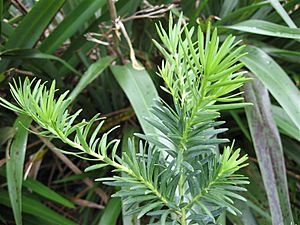Monoao facts for kids
Quick facts for kids Monoao |
|
|---|---|
 |
|
| Juvenile foliage | |
| Conservation status | |
| Scientific classification | |
| Genus: |
Halocarpus
|
| Species: |
kirkii
|
| Synonyms | |
|
Dacrydium kirkii Parl. |
|
The monoao (scientific name: Halocarpus kirkii) is a special type of tree. It belongs to a group of trees called conifers. Conifers are trees that usually have needles and cones, like pine trees.
This tree is part of the Podocarpaceae family. It is found only in New Zealand, meaning it is native and endemic there. This tree used to be known by a different name, Dacrydium kirkii.
Contents
What's in a Name?
Why is it called kirkii?
The scientific name kirkii was given to this tree to honor a famous botanist. His name was Thomas Kirk. Botanists are scientists who study plants.
All About the Monoao Tree
How the Monoao Looks
When you see a monoao tree from far away, it might remind you of a small kauri tree. Kauri trees are also very large and important trees in New Zealand.
The monoao tree can grow quite tall. It can reach about 25 meters (about 82 feet) high. Its trunk can be up to 1 meter (about 3 feet) thick. The bark on its trunk is grey-brown and feels rough. It has small bumps, like pustules.
The wood of the monoao tree is a pale reddish-brown color. It is known for being very strong and lasting a long time.
Monoao Leaves
The leaves of a young monoao tree look different from the leaves of an older tree. Young trees and the lower branches of adult trees have narrow, somewhat leathery leaves. These leaves can be up to 4 centimeters (about 1.6 inches) long and 3 millimeters (about 0.1 inches) wide.
As the tree gets older, its leaves change. The adult leaves are thick and look like small scales. These scale-like leaves overlap each other. They lie flat against the small branches in four neat rows.
Where the Monoao Lives
The monoao tree is not a very common tree. You can sometimes find it growing in lowland forests. These forests are usually below 700 meters (about 2,300 feet) in height.
It grows in the northern part of the North Island of New Zealand. You can also find it on Great Barrier Island, which is off the coast of the North Island.
See also
 In Spanish: Halocarpus kirkii para niños
In Spanish: Halocarpus kirkii para niños


